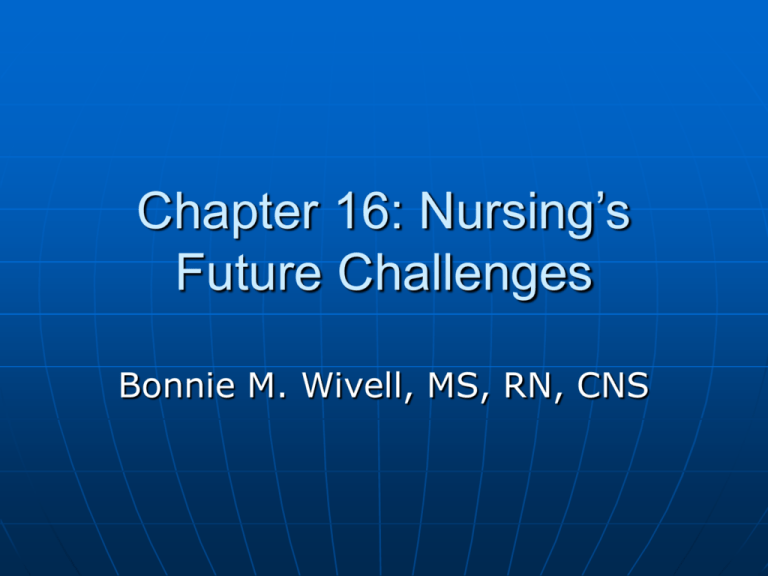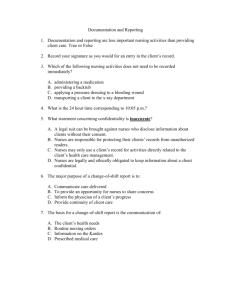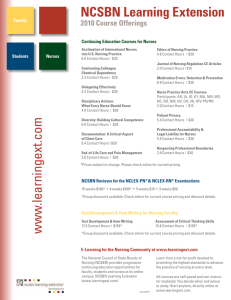Nursing's Future Challenges
advertisement

Chapter 16: Nursing’s Future Challenges Bonnie M. Wivell, MS, RN, CNS Overview U.S. is the wealthiest of the industrialized nations and still falls short of the goal of having a healthy nation in spite of spending nearly $2 trillion annually on health care 45 million Americans have no health insurance Infant death rates remain high – nearly 5 per 1000 babies Fitness levels declining as obesity is increasing U.S. spends more of its GDP (16% in 2004) on health than any nation in the world Societal Challenges Demographics: study of vital statistics and social trends • • • • • • Birthrates Morbidity rates (illness) Mortality rates (deaths) Marriages Ages of various populations Migration patterns Futurists: people who try to project what will occur, draw conclusions about what these trends mean for the future Societal Challenges Cont’d Aging Population: • By 2020, 21.8 million will be 75 + years old • “Baby boomers” knowledgeable, expect more and tolerate less • Centenarians: represent one of the fastest growing groups in the U.S. • 1 of 2 people over 90 will develop Alzheimer’s • Euthanasia/assisted suicide; Netherlands and Belgium legalized it • End of life care/palliative care Societal Challenges Cont’d Poverty • Working poor basic needs not met; has grown since reform of 1996 • Medically indigent don’t qualify for Medicaid but cannot pay for health care • Disenfranchised have no power in political system & limited access to health care, • Government with limited resources must look at more strategies for health care for these vulnerable populations Societal Challenges Cont’d Cultural diversity: people from different racial, ethnic, religious, social, & geographic backgrounds • Homogeneous: similar cultural beliefs and practices • Heterogeneous: cultural mix Nurses need to take cultural beliefs, values and practices into consideration when planning and implementing nursing care Urbanization: move from rural areas to cities • Decaying inner cities with large populations of poor people create major social problems Homelessness, drugs, gangs, single-parent households, mental illness, violence, and crime More Societal Challenges Environment: gradual deterioration of the world’s air, water, and plant and animal life Acute and chronic respiratory diseases, debilitating allergic reactions and cancers are increasing Epidemiologists study origin/spread of disease and believe that environmental decline increases incidence of certain diseases Emerging MDRS of organisms will challenge health care resources Disasters: an event or situation that is of greater magnitude than an emergency disaster; can be natural of man-made • Core preparedness competencies • Practice 2 times/year More Societal Challenges Cont’d. Bioterrorism: refers to use of biological or chemical agent as a weapon • Keep up with emerging information to be prepared • See CDC’s bioterrorism website Unhealthy life styles: obesity, tobacco use, lack of exercise, eating disorders, stress, HIV/AIDs and drug use Cost Containment: must do more with less Regulation of Health Care: costs rise with aging, increased use of advanced practice nurses for primary health care Challenges in Nursing Practice Differentiated Practice Levels: ADN/BSN, MS + • Should have different, well-defined roles • Possibly different levels of licensure • Only health care profession for which entry into practice is less than a baccalaureate degree • Credential for entry into a profession and educational standards are rising in all fields but nursing • This has hampered nursing’s quest for professionalism • Differentiated practice can only be realized if we give up the notion that “a nurse is a nurse is a nurse” Challenges in Nursing Practice Cost Containment: managed care, capitation • Nurses will need resource management skills • Business expertise will be needed as much as clinical experience • UAP utilization and delegation Autonomy & Accountability • Shared governance: participation by nurses on strong policymaking hospital committees; mandated by JACHO • Practice in community settings; autonomy and accountability will become increasingly important • Life long learning a requirement Technology & Nursing Informatics Nursing informatics: the organization and use of nursing data continue to change Telecommunication (telemedicine) will improve access to medical services for rural and elderly Genetic engineering & genomic revolution • Makes it potentially possible to treat & prevent genetically transmitted and predisposed diseases • Designer medicines are drugs tailor made to treat patients based on their individual genetic makeup Complementary & alternative therapies more utilized as persons take responsibility for their own health Internet can provide reliable medical & health information Challenges Continued Practice in Community Settings: Nurse managed clinics serve inner city/rural areas; school nurses needed in large numbers as well as hospice nurses and those specializing in gerontology and chronic illnesses Cultural Competence: patient/families & health care providers cultural sensitivity due to change in the nation’s demographics Maintaining Health Work Environment: needle sticks, latex allergy, shift work, risk of violence in workplace, bloodborne diseases, back injuries Challenges in Nursing Education Outcome-based Education: student competency and evidence-based education required to maintain accreditation Diversity: students reflect US demographics; culturally competent education; distance learning increases access • Education about chronic diseases, gerontology, hospice • Foreign language requirement for BSN • Culturally competent care as an outcome criterion for graduates Challenges in Nursing Education Continued Technology & Nursing Informatics’ Impact • Computer competence • Internet utilization • Faculty required to actively practice to keep up with changes • Lifelong learning a requirement • NCLEX changes • New grad internships Challenges Continued Collaboration: Nurses with more education equal footing with physicians & others, interdisciplinary Reforms in Health Care & Higher Education: • Graduate education producing practitioners to meet consumer demands • Curricula standardized & streamlined to reduce cost and confusion and improve student mobility • Nurses will need to be well versed in the costs, budgeting and finance of health care Faculty Shortage/Student Shortage: current faculty retire, few younger nurses into education as salaries lag; students turned away as no one to teach them; fewer students means fewer nurses; medical schools respond by producing hospitalists (care for patients only while hospitalized) Challenges to Entire Nursing Profession As the largest health care profession in the US, nursing should have a powerful voice and presence at every table where substantive health care issues are discussed. Use of Collective Power to resolve issues, but only 10% of all nurses belong to their professional association Nursing Agenda for Future: • 2001 Nursing Profession Summit (ANA grant) • Steering committee formed and established the document entitled Nursing’s Agenda for the Future • How nursing should look and where it should be by the year 2010; you help decide; involve nurses in charting own future Nurses can accomplish more working together FOCUS, UNITE, ACT! “Be the change you wish to see in the world”






